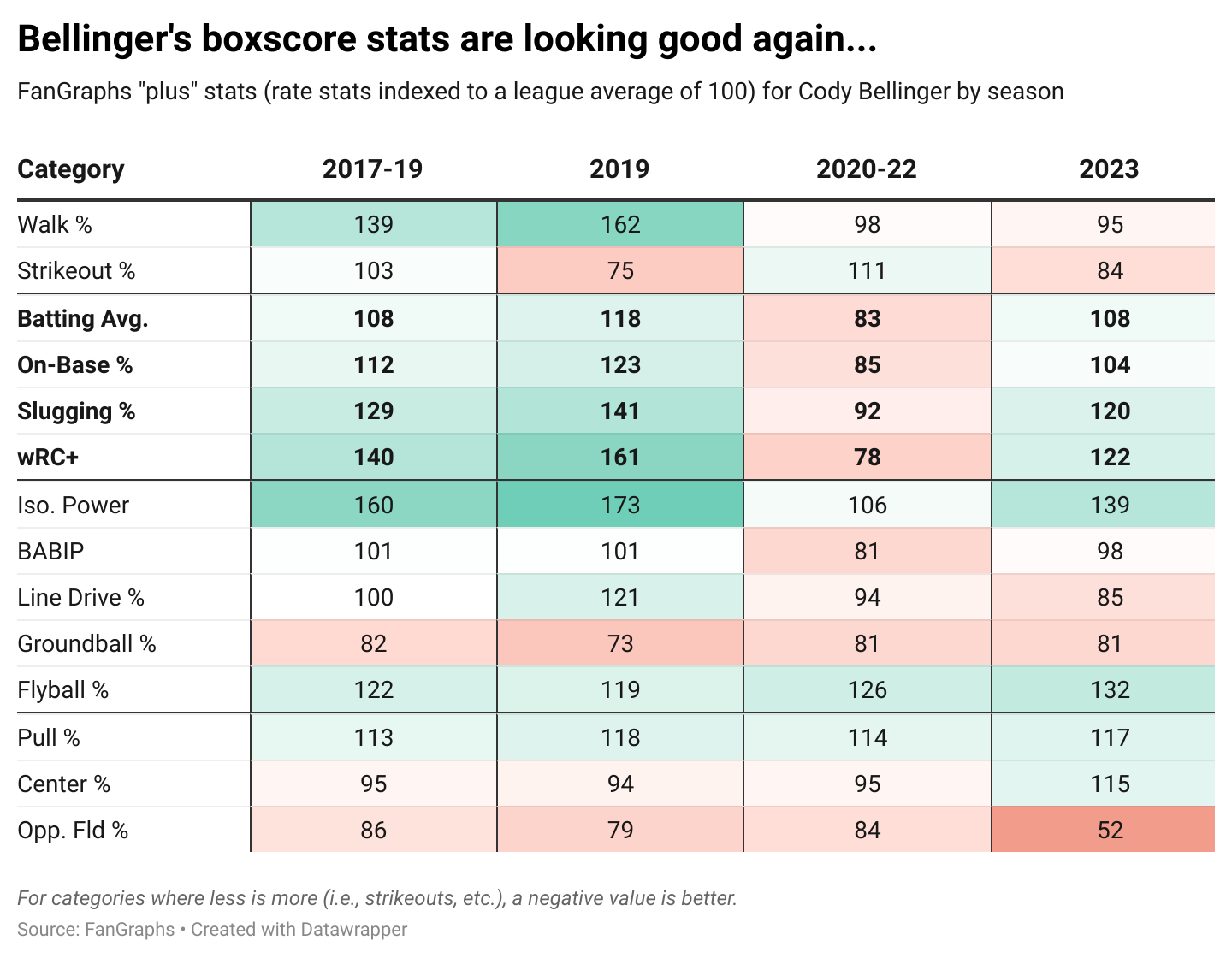Cody Bellinger Is Back — Sort Of
The lefty slugger looks more like his old self with the Cubs, but can it last?
When he was fully locked in as the 2019 National League MVP, mashing 47 home runs and winning a Gold Glove for the L.A. Dodgers, few players were more fun to watch than Cody Bellinger. His signature uppercut swing allowed him to turn on and punish any pitch, and his plate discipline was a marvel: only five players had a better walk-to-strikeout ratio that season than Bellinger — and among those, only Mike Trout had a better isolated power. Plus, the scariest part was that Bellinger was only 23 years old. It truly felt like his future was limitless.
Now it feels like all of that was a lifetime ago. Instead of continuing his ascent with more Hall of Fame-type seasons, Bellinger reverted to merely being good (not great) in the pandemic-shortened 2020 campaign — including an up-and-down postseason despite L.A. winning the World Series — and was outright awful in 2021, with an OPS 56% worse than average and negative-1.3 Wins Above Replacement. After another better, but still below-average, performance in 2022, the Dodgers did what would once have been unthinkable and didn’t tender Bellinger a contract last offseason. Now on a one-year, make-good deal with the Chicago Cubs, Bellinger is at a career crossroads nobody saw coming just a few years earlier.
So far, though, he’s been making the most of his opportunity. As of Tuesday, Bellinger is hitting a much more Bellinger-like .271/.337/.493 for the Cubs, a vast improvement over his .203/.272/.376 slash line during his final three seasons in Dodger blue. He’s also on pace for 5.9 WAR per 162 team games, nearly 2 full wins better than any year he’s had since 2019 — assuming he doesn’t miss any significant time after the knee-injury scare he suffered Monday night while making a spectacular catch at the wall against the Houston Astros.
After the game, both manager David Ross and Chicago’s starting center fielder himself sounded optimistic that Bellinger would be back in action sooner rather than later, although he’s currently listed as day-to-day. But even if Bellinger returns quickly to try and pick up his hot start where it left off, there are reasons to think Bellinger’s feel-good comeback might start to slow down.
At a top-line level, there’s a lot to like about Bellinger’s numbers so far in 2023. If we look at FanGraphs’ “plus” stats — which index various rates to a league average of 100 — Bellinger’s batting average and slugging are almost exactly back in line with his relative performance with the Dodgers from 2017-19, and his OBP isn’t too far off. All numbers are significantly better than his combined numbers across the 2020-22 seasons, when Bellinger hit his prolonged, multi-year slump.
He even seems to have regained one of his best attributes of that 2019 MVP campaign — his ability to avoid striking out despite that powerful, but seemingly quite long, swing.
Bellinger hasn’t, however, pieced back together all of the components of his peak form yet. His walk rate has fallen from 40-60% better than average during his Dodger heyday to 5% below average this season, a product of swinging at the first pitch more often and generally getting into fewer good hitters’ counts than he did several seasons ago. Moreover, it’s not clear the other changes he’s made to his approach since then are entirely beneficial: Bellinger is hitting more balls up the middle but profiles as pull-heavy as ever, instead sacrificing hits to the opposite field; he’s also traded line drives for fly balls, even as MLB’s post-juiced ball era rewards those less than any other time in Bellinger’s career.
But maybe the most concerning part about the sustainability of Bellinger’s bounceback comes from Statcast’s tracking data. Here’s a comparison of relative rankings by season for Bellinger in Baseball Savant’s array of percentile categories:
While Bellinger’s speed and defense remain very impressive for any player, much less a man of his 6-foot-4 frame, the rest of his 2023 Statcast data looks a lot more like his slump years than his MVP prime. In fact, his percentiles this season in the “expected” stats — which use tracking data to assign probabilities for different batted-ball outcomes as a way of filtering out the distortions of luck — are almost carbon copies of his ranks from 2020-22. And in terms of exit velocity and hard-hit ball rate, Bellinger is faring even worse than during those down seasons, with a career-low placement in each category.
That’s admittedly a dispiriting thing to discover under the hood for a player whose comeback is easy to root for. And maybe Bellinger will be able to sustain his better-than-expected output by improving on those outlier Statcast rates, which are low by the standards of the rest of his career (peak years or not). Because one thing is for certain: baseball is a more fun game when a player like Bellinger is doing the kinds of things he was capable of doing back in 2019.
Filed under: Baseball







